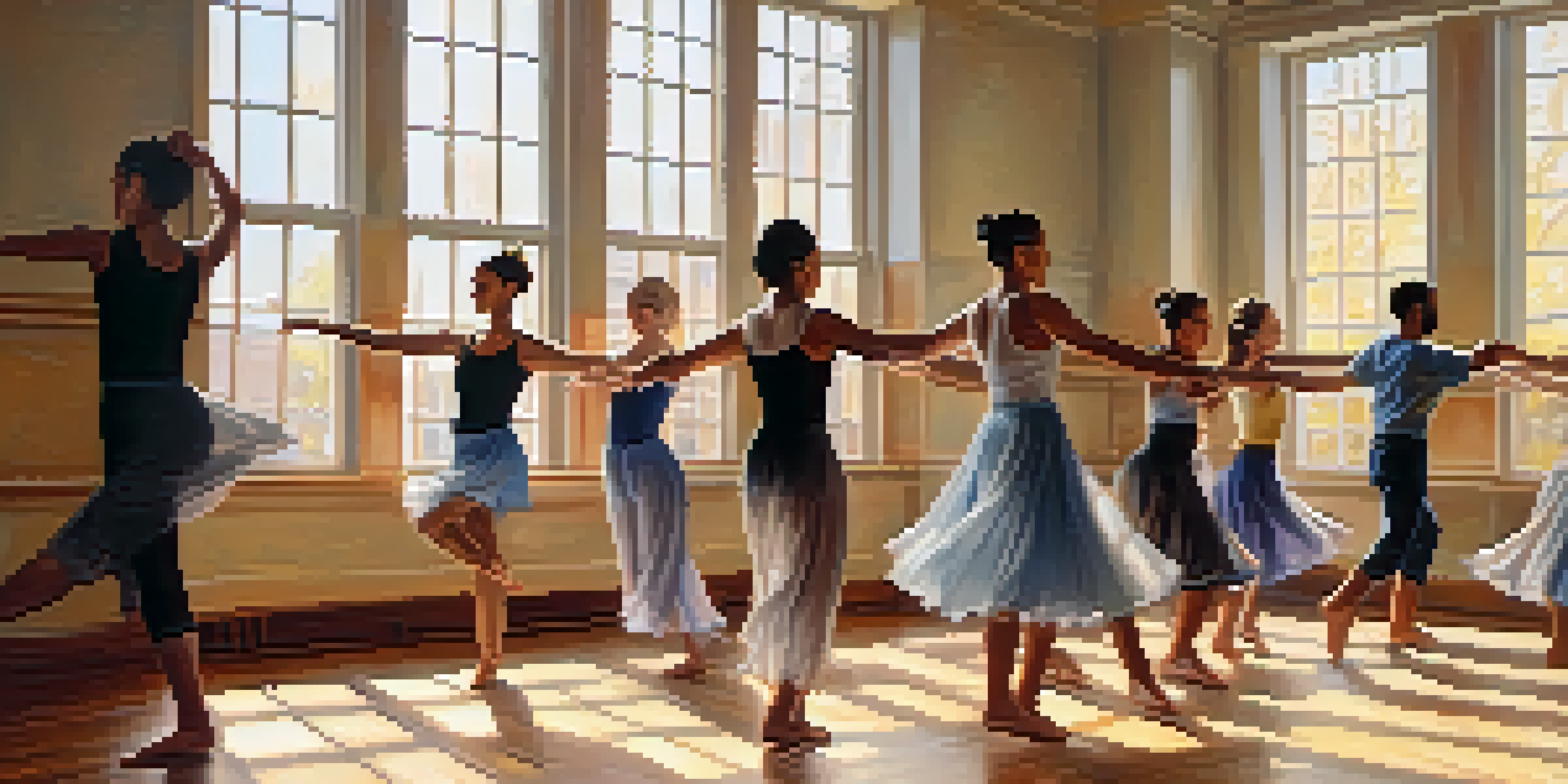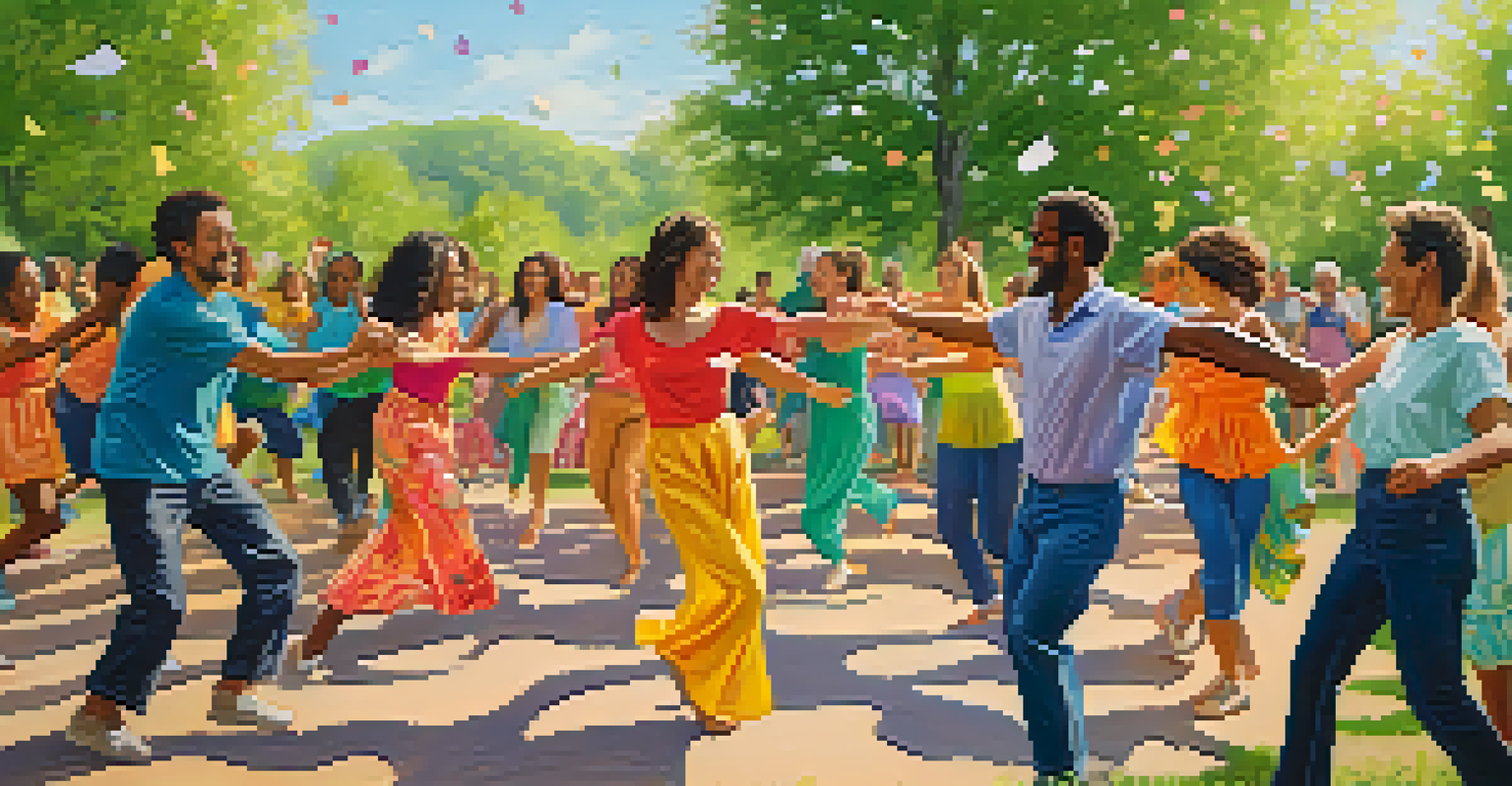Dance Therapy: Innovative Approaches for Healing and Expression

Understanding Dance Therapy: What Is It?
Dance therapy, also known as dance/movement therapy (DMT), is a form of expressive therapy that uses movement to support emotional, cognitive, and physical integration. It focuses on how the body moves and the emotions that accompany those movements, offering a unique avenue for healing. By engaging in dance, individuals can express feelings that may be difficult to articulate verbally, creating a bridge between the body and mind.
Dance is the hidden language of the soul.
This therapeutic approach is grounded in the belief that movement can reflect our inner experiences, allowing therapists to observe clients' physical expressions and emotional states. It's not just about dancing; it's about using dance as a language for expression and connection. Whether it's through improvisation, structured dance, or even simple movements, the body becomes a vessel for exploration and healing.
Dance therapy can benefit a wide range of individuals, from those dealing with trauma to those seeking personal growth. By encouraging self-awareness and emotional release, it helps people reconnect with their bodies and cultivate a sense of agency in their healing journey.
The Science Behind Dance Therapy: Why It Works
Research has shown that dance therapy can significantly impact mental health by reducing symptoms of anxiety and depression. When we dance, our brains release endorphins, the 'feel-good' hormones, which can elevate mood and promote relaxation. This physiological response, coupled with the emotional release that comes from movement, creates a powerful healing dynamic.

Additionally, dance therapy can enhance social connections and improve communication skills. Group therapy sessions often involve collaborative dances, helping participants build trust and support one another in their healing journeys. This sense of community fosters empathy and understanding, which are crucial for recovery.
Dance Therapy as Healing Tool
Dance therapy uses movement to facilitate emotional expression and healing, providing a unique bridge between the body and mind.
Moreover, the practice of dance therapy encourages mindfulness, as participants focus on their movements and bodily sensations. This heightened awareness can lead to improved self-esteem and body image, empowering individuals to embrace their physical selves and express their emotions freely.
Innovative Approaches: Techniques in Dance Therapy
Dance therapy is not a one-size-fits-all approach; it comprises various techniques tailored to meet individual needs. Some common methods include improvisation, where clients are encouraged to move spontaneously, allowing for personal expression without judgment. This technique can be liberating, as it encourages people to explore their emotions and release pent-up feelings.
Movement is a medicine for creating change in a person's physical, emotional, and mental states.
Another innovative approach is choreographed movement, where clients learn specific dance routines that resonate with their experiences. This structured form of dance can provide a sense of accomplishment and mastery, helping individuals regain control over their lives. Additionally, it can serve as a metaphor for overcoming challenges, as participants learn to navigate the steps of a dance.
Incorporating elements of storytelling into dance therapy can also enhance self-expression. By weaving personal narratives into their movements, clients can articulate their experiences more vividly, transforming pain into art. This creative process not only fosters healing but also encourages reflection and growth.
Dance Therapy for Trauma Recovery: A Safe Space
For individuals who have experienced trauma, dance therapy can provide a safe and nurturing environment to process their experiences. The freedom of movement allows clients to express emotions that may be too painful to verbalize, facilitating healing in a non-threatening way. This can be especially beneficial for survivors of abuse or those grappling with post-traumatic stress disorder (PTSD).
Creating a supportive space is essential in dance therapy, where clients can explore their feelings without fear of judgment. Therapists play a crucial role in guiding participants through their emotional landscapes, helping them to feel secure as they navigate their movements. This relational aspect reinforces the idea that healing is a shared journey.
Community Benefits in Group Therapy
Group dance therapy fosters a sense of belonging and connection, enhancing the therapeutic experience through shared movement and support.
By integrating movement with therapeutic techniques, dance therapy helps clients reclaim their bodies and establish a sense of safety. As they learn to trust their bodies again, individuals can gradually reduce the hold that trauma has over them, emerging stronger and more resilient.
The Role of Music in Dance Therapy: A Harmonious Blend
Music is a vital component of dance therapy, serving as both a backdrop and a catalyst for movement. The rhythms and melodies can evoke emotions and memories, enhancing the overall experience. Clients often find that music helps them connect with their feelings, making it easier to express themselves through dance.
Different genres of music can influence the type of movement and emotional release that occurs during sessions. For example, upbeat songs may inspire joyful and energetic movements, while slower melodies can facilitate introspection and calmness. This versatility allows therapists to tailor sessions to meet the specific needs and emotional states of their clients.
Moreover, the interplay between music and movement fosters a deeper connection to one’s body, promoting a sense of unity and flow. As clients move to the music, they may find themselves more in tune with their emotions, leading to cathartic releases and powerful insights into their healing process.
Group Dynamics in Dance Therapy: Building Community
Group dance therapy sessions provide an opportunity for individuals to connect and share their experiences in a supportive environment. The collective energy of a group can amplify the therapeutic benefits, creating a sense of belonging and acceptance. Participants often find solace in knowing they are not alone in their struggles, which can be incredibly empowering.
These sessions encourage collaboration and communication, as participants engage in group movements or partner dances. This interaction helps to build trust and rapport among members, fostering a sense of community that is essential for emotional healing. Over time, these connections may lead to lasting friendships, further enhancing the therapeutic experience.
Innovations in Dance Therapy
Emerging trends like technology integration and diverse cultural practices are enriching dance therapy, making it more effective and inclusive.
Additionally, witnessing others express their emotions through dance can be inspiring and validating. Clients may find courage in watching their peers navigate similar challenges, motivating them to explore and express their own feelings more freely. This shared journey can be a transformative aspect of the healing process.
The Future of Dance Therapy: Trends and Innovations
As the field of dance therapy continues to evolve, new trends and innovations are emerging that enhance its effectiveness. For instance, the integration of technology, such as virtual reality and wearable devices, is beginning to play a role in therapy sessions. These tools can provide immersive experiences that deepen emotional engagement and facilitate movement exploration.
Additionally, there is a growing emphasis on research and evidence-based practices within the field. As more studies highlight the benefits of dance therapy, practitioners are developing standardized protocols to ensure consistent and effective treatment. This focus on accountability and outcomes is helping to elevate the profession and attract wider recognition.

Furthermore, the incorporation of diverse cultural practices and styles of dance is enriching the landscape of dance therapy. By embracing various forms of movement from around the world, therapists can offer clients a broader palette of expressive options, making the healing process more inclusive and personalized.